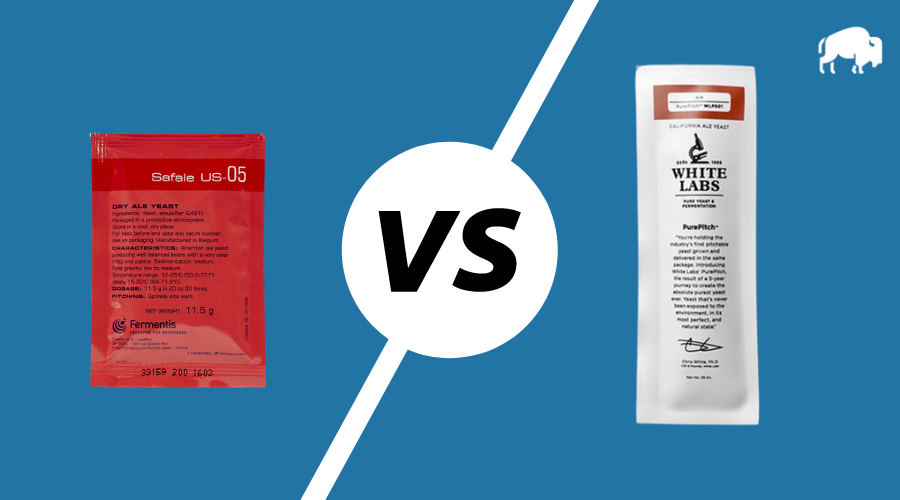Dry yeast or liquid yeast – what should you use for your next batch of homebrew? Liquid yeast has long been thought to be a superior product. But dry yeast technology has advanced to offer some amazing and versatile yeast options.

We’ll explore the differences between liquid and dry yeast and highlight some of our favorite yeast labs and strains in each format.
What’s the difference between dry yeast and liquid yeast?
Liquid yeast is a liquid slurry of yeast cells packaged in a sterile pouch or vial. Dry yeast has undergone a dehydration process, removing all of the moisture. Because it’s dry, the yeast has a much better shelf life. It also doesn’t need to be refrigerated – although we still recommend storing dry yeast in the fridge just to be safe.
For a lot of brewers, dry yeast has a bit of a poor reputation compared to liquid yeast. Once limited to very few strains, dry yeast was quite one dimensional. Even 10 years ago, there were only a handful of clean ale strains and a lager strain or two. These days, new dry yeast options are propagating every day.
Liquid yeast is easier to produce for yeast labs. The drying process requires specific, and expensive, equipment and procedures. Plus, certain strains don’t take well to drying. For this reason, there are far more options when it comes to liquid yeast. Every single type of brewer’s yeast you want will be available in liquid form.
For funky and sour beer brewers, liquid yeast is an absolute must. Though dry yeast labs are starting to make sour strains, there’s no comparison with the range the liquid yeast labs currently offer.
Advantages and Disadvantages: Liquid Yeast vs. Dry Yeast
| Dry yeast | Liquid yeast |
|---|---|
| Advantages | |
| Long term storage | Endless strains available |
| Low cost | Trendy, seasonal, and new yeast strains |
| High cell count | Very viable when fresh |
| Readily available | |
| Oxygenating wort not essential | |
| Disadvantages | |
| Far fewer available strains | More expensive |
| Lower cell count if not fresh | |
| Harder to store - needs refrigeration | |
| Wort oxygenation necessary | |
Dry yeast labs
Dry yeast labs have invested in equipment and R&D to optimize the drying and packaging processes. Manufacturing dry yeast takes specialized tools and know-how. When you open a pack of dry yeast, you expect consistent quality, high viability, and sterile packaging.
The dry yeast market is dominated by two main players: Lallemand and Fermentis. There are a few other labs starting to pick up a bit of steam, most interestingly Mangrove Jack’s.
Lallemand
A fermentation giant, Lallemand produces yeast for industries including brewing, baking, and pharma. Known for their high quality standards, brewers can trust that their dried yeast is consistent and stable.
In the last two years, Lallemand’s released some very exciting new dry yeast strains. Keeping up with trends, they’ve released cool strains for NEIPA, sours, and Belgian styles. Look out for the LalBrew and WildBrew product lines.
Recommended strains: LalBrew Belle Saison, LalBrew Voss Kveik, WildBrew Helveticus Pitch
Fermentis
Fermentis produces the most commonly used brewer’s yeast, SafAle US-05. It’s a Chico strain that ferments extremely clean and reliably. This strain is loved by brewers worldwide and is a staple in most brewers’ toolboxes.
On top of US-05, Fermentis offers a range of ale and lager yeasts, and have even started producing dry souring bacteria. Don’t expect anything too out-of-the-box from this lab. They’re committed to exceptional quality across their relatively limited range.
Recommended strains: SafAle US-05, SafLager W-34/70, SafAle S-04
Mangrove Jack’s
Out of New Zealand, Mangrove Jack’s supplies the homebrewing world with all types of equipment and ingredients. They’ve recently started selling a wide range of dry yeast, and the quality and flavor profiles are impressive.
Offering many strains once only available in liquid form, Mangrove Jack’s is an excellent option for unique flavors with the ease of dry yeast.
Recommended strains: M66 Hophead Ale, M84 Bohemian Lager
Liquid yeast labs
There are quite a few liquid yeast labs. Because the equipment to make liquid yeast requires less investment, boutique labs have sprung up around the globe. You can find nearly every strain you need in a liquid yeast format from one of these great labs.
Here are our favorite liquid yeast labs that cover any type of yeast, bug, or bacteria that you’d like.
Wyeast Laboratories
Producing a wide range of high quality yeast for nearly 35 years, Wyeast is still one of the most reputable and respected yeast labs. Based in Hood River, Oregon, their products can be found in every corner of the world.
Wyeast is known for their “Smack Pack Activators”. Inside each packet of Wyeast homebrew-size pitches, there is a small pack of yeast nutrient that you burst a few hours before pitching the yeast. The nutrient is said to proof the yeast, preparing it for a healthy fermentation when it hits your wort. At the very least, it’s a nice check to make sure the yeast is healthy and viable… plus it’s always fun to smack the pack.
Recommended strains: 1318 London Ale III, 3763 Roeselare Ale Blend, 2565 Kölsch
White Labs
White Labs founder, Chris White, literally wrote the book on yeast. Founded in San Diego in 1995, White Labs has an extensive library of strains and a very solid reputation.
The end-all, be-all book on brewer's yeast and yeast management.
From their classic Chico strain, WLP001 American Ale, to the wild world of Brett and bacteria, White Labs covers all types of brewing.
Recommended strains: WLP565 Belgian Saison I, WLP644 Saccharomyces “bruxellensis” Trois, WLP400 Belgian Wit
Omega Yeast
Offering a great mix of high quality yeast and bacteria, Omega Yeast produces amazing and innovative strains. Their catalogue covers all aspects of the brewing world. From pure and clean ales and lagers, to bold, funky Brettanomyces and souring bacteria, Omega’s yeast is always a great choice.
Omega was also one of the first commercial yeast labs to sell Norwegian kveik and other landrace yeast. They continue to innovate and offer pros and homebrewers a modern selection of standard to uncommon strains.
Recommended strains: OYL-091 Hornindal Kveik, OYL-033 Jovaru Lithuanian Farmhouse, OYL-217 C2C American Farmhouse
Escarpment Labs
As Canada’s finest boutique yeast supplier, Escarpment Labs is at the cutting edge of yeast strains and current popular beer styles. They place a focus on helping brewers, both pros and hobbyists, understand yeast science.
The Escarpment website and YouTube channel are troves of great information regarding yeast. Learn about topics like biotransformation, diacetyl, and haze formation. These guys know their stuff, but honestly the incredible yeast speaks for itself.
Recommended strains: Krispy, Foggy London Ale, Autobahn Lager
Bootleg Biology
Small and niche, Bootleg Biology is a favorite for sour beer and funk-focused brewers. Their name comes from the fact that all of their strains of yeast and bacteria are wrangled from wild sources and/or bottle dregs. Despite being mainly wild yeast strains, they have a nice array of clean fermenting yeast as well as their core funky and sour strains.
Recommended strains: The Mad Fermentationist Saison Blend, Saison Parfait, NEEPAH Blend
Imperial Yeast
A recent success story in the beer yeast industry, Imperial has taken the pro and home brewing world by storm. They’ve been around since 2014, with labs on each coast of the U.S. in Portland, Oregan and Philadelphia, Pennsylvania.
Imperial has a distinct focus on high quality yeast and is alway at the forefront of popular strains and new varieties. On top of that, they’re certified organic.
Recommended strains: A34 Julius, B56 Rustic, L17 Harvest
Final Thoughts
Choosing the format of yeast – whether dry or liquid – to ferment your beer shouldn’t be the deciding factor. Find a strain, liquid or dry, that works best for the beer you’re brewing. Neither one of dry yeast or liquid yeast is better. You can count on the professionals at the yeast labs to produce high quality yeast, no matter the format.
That said, we couldn’t be more pleased to see the recent advancement in dry yeast availability. The shelf life, ease of storage, and consistent viability of dry yeast makes it easy to have multiple packs of yeast on hand. If you like experimenting with many styles, you’ll probably find yourself gravitating to liquid yeast due to the range of strains.


